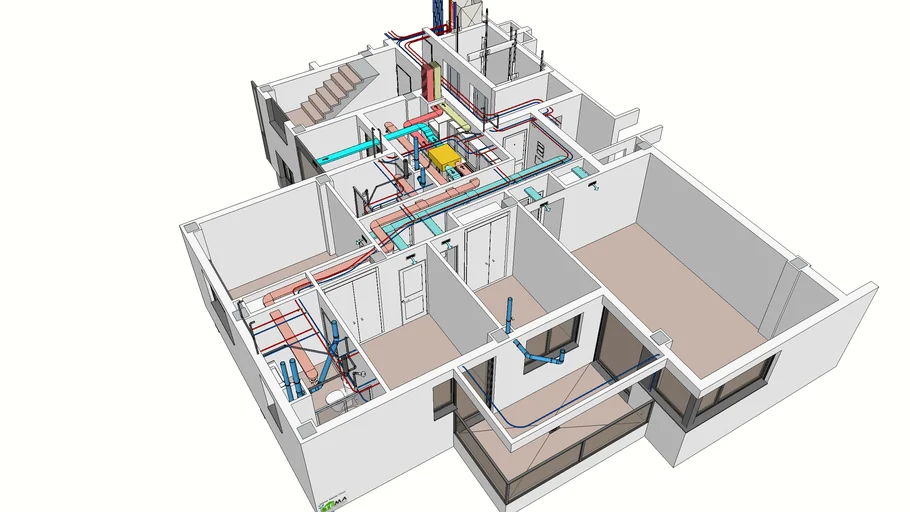Modern mechanical installations
for housing in Yucatan
In the Yucatan Peninsula, the Vivienda para el Bienestar (Housing for Well-being) program is opening up a great opportunity to rethink how social housing is built. But beyond the basic structure, today we will focus on an often-underestimated aspect: mechanical installations (air conditioning, ventilation, plumbing, and even thermal efficiency) and how mechanical engineers can make a difference in these types of projects.

Why are mechanical installations important?
When we think of social housing, the first thing that comes to mind is walls, ceilings, windows, etc. But for a home to truly function (in terms of comfort, efficiency, and durability), mechanical installations are key. In Yucatan, with its hot and humid climate, poor ventilation or inadequate air conditioning can lead to uncomfortable conditions, higher maintenance costs, or even premature deterioration of materials. Therefore, a very important window of opportunity for work and responsibility is opening up for mechanical engineering professionals.
Specific challenges in Yucatan
In places such as Yucatan, local factors play a fundamental role: high humidity, high temperatures, limited natural ventilation in some areas, soils with particular geological characteristics, and even exposure to intense sunlight. This means that the mechanical system must be considered not as an add-on, but as an integral part of the design from the early stages. For example: Was adequate cross ventilation planned? Was an efficient air conditioning system selected for social housing? Were thermal insulation and duct placement considered to minimize energy loss? These questions are very real when building on a large scale in a program such as Vivienda para el Bienestar (Housing for Well-being).
Opportunities for innovation in mechanical engineering
For mechanical engineers, this large-scale construction project represents a laboratory for applying innovations: from thermal modeling to predict behavior in summer, to the integration of more affordable air conditioning systems, or the use of mechanical ventilation in areas where natural ventilation is insufficient. There is also room for more modern technologies: sensors that detect humidity, automation systems to optimize consumption, and even the application of renewable energies (solar panels for hot water pumps, efficient fans, etc.). While not all social housing projects can afford high technological costs, applying “good mechanical practices” can make a substantial difference.
Best practices and applicable standards
The construction team should establish certain minimum standards from the outset:
- Design mechanical installations in conjunction with architecture, not as an afterthought.
- Select energy-efficient equipment adapted to the local climate.
- Ensure that ducts, pipes, and mechanical systems are accessible for maintenance and operate properly.
- Supervise the installation of air conditioning, ventilation, and hot water systems as part of the commissioning process, not after its finished.
- Document the maintenance plan so that the home retains its functionality in the medium and long term.
By adopting these guidelines, mechanical engineering not only deals with “installing machines,” but also ensures that the home fulfills its role as a comfortable, accessible, and low-cost home for the end user.
Impact on quality of life and operation
Social housing is often designed to provide “the basics” and reduce costs. But if the basics do not include well-designed mechanical systems, the house can become problematic: excessive heat, condensation, humidity, expensive maintenance, etc. A well-designed mechanical system improves the quality of life of the inhabitants, reduces energy consumption, extends the useful life of the materials, and even contributes to the sustainability of the project. Consequently, the housing project in Yucatan should be considered not only as “providing a roof,” but as providing housing that works from a mechanical, structural, and operational standpoint.
Integration of construction and mechanical engineering
In large programs such as the one being carried out in Yucatan, collaboration between architects, civil engineers, mechanical engineers, and contractors is essential. It is a common mistake to address mechanical installations at the end, when the bulk of the work is already done. But the ideal approach is to plan from the preliminary design phase: duct routes, ventilation, location of air conditioning units, water pipes, pumps, ventilation systems, etc. Otherwise, costs, maintenance challenges, and risks of malfunction increase. For mechanical engineering professionals, the invitation is clear: prepare your intervention from the first plans, with a comprehensive vision.
Economic and maintenance considerations
Another point that should not be overlooked is the cost of operation and maintenance. Social housing that requires air conditioning equipment that is very expensive to repair or consumes a lot of electricity can become a burden for the user. Here, mechanical engineering must include criteria such as service life, ease of operation, accessible spare parts, and end-user training. For example: explaining to residents how to maintain filters, how natural ventilation can complement the mechanical system and reduce the use of air conditioning. This ensures that the housing functions properly not only upon delivery, but throughout the years.
Finally, sustainability is becoming an increasingly important factor. In Yucatan and other warm areas, reducing energy consumption, using efficient natural ventilation, or low-impact air conditioning systems represent significant added value. Mechanical engineering can contribute by implementing better equipment, integrating clean energy, or proposing materials that improve the thermal performance of the building. This not only improves individual housing but also benefits the environment, the city, and the reputation of the social housing program in general.
In summary, when considering the ambitious social housing program in Yucatán, it is not enough to meet the number and land requirements; it is essential to ensure that mechanical systems function properly, such as ventilation, air conditioning, hot water, maintenance, and energy efficiency. For mechanical engineers, this is a significant opportunity: they can and must take a leading role in ensuring that these homes deliver on their promise of real well-being, now and in the future. After all, a well-designed home is no longer just “my dream house” but becomes “the functional, comfortable, and sustainable home my family deserves”.